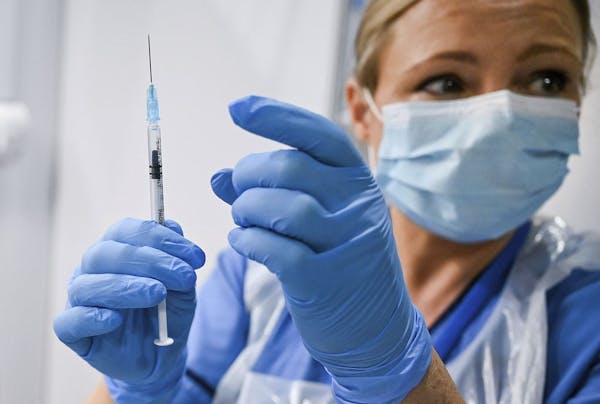Minnesota has reached two opposing milestones in the COVID-19 pandemic, reporting Thursday that more than 500,000 people have suffered known infections and more than 2 million doses of vaccine have been administered.
The notable figures come as health officials detect a slight uptick in COVID-19 activity in Minnesota, despite more than 23% of people having received vaccine against the infectious disease. That includes 77% of senior citizens at greater risk of severe COVID-19.
"Hope is on the horizon," Gov. Tim Walz said in a statement regarding the vaccine milestone, despite being quarantined himself until March 25 due to exposure to the virus.
The governor's COVID-19 test on Thursday was negative.
The emergence of more infectious variants of the coronavirus that causes COVID-19 appears to be fueling some increase in pandemic activity despite the vaccination progress. The positivity rate of diagnostic testing had dropped from a peak of 15.4% on Nov. 9 to 3.3% on March 3 before rising back to 4.1%.
Hospitalizations also have increased in Minnesota, where the number of COVID-19 patients needing intensive care doubled from 37 on March 6 to 74 on Wednesday. However, the hospital figure remains below the peak of 399 COVID-19 ICU cases on Dec. 1.
The average age of COVID-19 patients admitted to M Health Fairview hospitals in the Twin Cities is almost a decade lower than it was during that winter peak, said Dr. Andrew Olson, the system's medical director for COVID-19 Hospital Medicine.
"To me, that says that both the elderly population may be slightly less at risk, and young people continue to drive this pandemic," he said.
The pandemic from the start has involved less severe or even asymptomatic cases among younger people who unknowingly transmit the virus to older people at greater risk. People 35 or younger have sustained 52% of Minnesota's 501,458 known infections but 0.7% of its 6,762 COVID-19 deaths. People 65 and older have suffered 13% of infections but 89% of the deaths.
The state's pandemic totals include six deaths and 1,505 diagnosed infections reported on Thursday.
Friday is the anniversary of Minnesota's first COVID-19 death — an 88-year-old St. Paul resident who had been in contact with relatives who had traveled outside the country.
State health officials hope aggressive testing will help to identify and limit the spread of SARS-CoV-2 and its new variant forms. Free testing is taking place at a state pop-up site in Aurora, Minn., on Monday and Tuesday in response to a recent rise of cases in the East Range region of St. Louis County.
Mayors of Aurora, Biwabik and Hoyt Lakes joined in a statement in support of the testing, encouraging it as a defense against a surge that could upset business activity and badly needed tourism and resort traffic.
"Let's make sure we don't have another spike so we can have a normal summer," Hoyt Lakes Mayor Chris Vreeland said.
Testing at another state pop-up site will conclude this weekend in Chanhassen, where a cluster of infections has been traced to youth sports activities and the B.1.1.7 viral variant that has been problematic in Europe.
Diagnosed infections have increased statewide among K-12 schoolchildren, according to Thursday's weekly COVID-19 activity report from the Minnesota Department of Health. More than 600 diagnosed infections in K-12 students and staff were detected in the seven-day period ending March 13, compared with a weekly tally of 400 in the week ending Feb. 14.
Increased testing of K-12 students is somewhat responsible for the higher numbers and the detection in some cases of asymptomatic infections that might not have otherwise been found. However, both the rate of testing and positivity have increased in the 10-to-19 age group in Minnesota, suggesting an actual increase in viral transmission.
All K-12 students are encouraged to seek weekly testing, while young athletes are encouraged to seek testing once a week or three days before any competition.
Minnesota's total infection count only includes those detected through diagnostic testing. Health officials have estimated that anywhere from 20 to 30% of Minnesotans have actually been infected over the past year, when accounting for asymptomatic or untested cases. So the actual count could be 1.5 million or more.
Shots have been provided to 1,303,210 people, including 764,275 who have completed the series either by receiving two doses of Moderna and Pfizer COVID-19 vaccines or one dose of the Johnson & Johnson vaccine.
Public mask-wearing and social distancing restrictions remain in effect as Minnesota enters its first weekend under Walz's relaxed restrictions that allow fuller bars and restaurants and no numerical caps on worship services.
Federal health authorities advise against spring break travel, but airports are braced for a rush of pandemic-weary vacationers.
Minneapolis-St. Paul International Airport is expecting 21,300 to 23,500 passengers going through security checkpoints in each of the next four days, below the peak day in the pandemic of 26,000 passengers on March 12. Passenger numbers remain 40% below a typical March spring break period.
Jeremy Olson • 612-673-7744

8 Twin Cities area grocery stores, ranked by affordability

